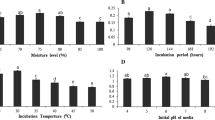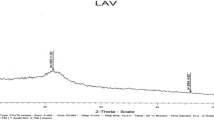Abstract
Water hyacinth (Eichhornia crassipes), an aquatic weed common to the subtropic/tropical regions, was utilized as an inexpensive lignocellulosic substrate for production of cellulase by Trichoderma reesei. The effects of process parameters like substrate pretreatment, substrate concentration, initial medium pH, mode of inoculation, and incubation temperature on cellulase production were investigated. Under optimal conditions, a maximal cellulase activity of 0.22 ± 0.04 IU/ml (approximately 73.3 IU/g cellulose) was recorded at the end of 15-day incubation period. Specific activity of the enzyme was 6.25 IU/mg protein. Hydrolysis of 1% substrate (water hyacinth) using crude enzyme dosage of 1.2 IU/g water hyacinth showed 28.7% saccharification in 1 h. The observations in present study indicate that saccharification of cellulose from water hyacinth was significantly higher by laboratory-produced cellulase than the commercial blend.




Similar content being viewed by others
References
Bhat, M. K. (2000). Biotechnology Advances, 18, 355–383. doi:10.1016/S0734-9750(00)00041-0.
Bhat, M. K., & Bhat, S. (1997). Biotechnology Advances, 15(3–4), 583–620. doi:10.1016/S0734-9750(97)00006-2.
Lee, C. K., Darah, I., & Ibrahim, C. O. (2007). Bioresource Technology, 98, 1684–1689. doi:10.1016/j.biortech.2006.05.052.
Bayer, E. A., Lamed, R., & Himmerl, M. E. (2007). Current Opinion in Biotechnology, 18, 1–9. doi:10.1016/j.copbio.2007.04.004.
Gullon, B., Yanez, R., Alonso, J. L., & Parajo, J. C. (2008). Bioresource Technology, 99(2), 308–319. doi:10.1016/j.biortech.2006.12.018.
Gray, K. A., Zhao, L., & Emptage, M. (2006). Current Opinion in Chemical Biology, 10(2), 141–146. doi:10.1016/j.cbpa.2006.02.035.
Olsson, L., & Hahn-Hagerdahl, B. (1996). Enzyme and Microbial Technology, 18, 312–331. doi:10.1016/0141-0229(95)00157-3.
Luo, J., Xia, L. M., Lin, J. P., & Cen, P. L. (1997). Biotechnology Progress, 13(6), 762–767. doi:10.1021/bp970100h.
Cao, N. J., Xia, Y. K., Gong, C. S., & Tsao, G. T. (1997). Applied Biochemistry and Biotechnology, 63–65, 129–139. doi:10.1007/BF02920419.
Ryu, D., & Mandels, M. (1980). Enzyme and Microbial Technology, 2, 91. doi:10.1016/0141-0229(80)90063-0.
Abd El-Nasser, N. H., Helmy, S. M., & El-Gammal, A. A. (1997). Polymer Degradation & Stability, 55, 249–255. doi:10.1016/S0141-3910(96)00117-6.
Doppelbauer, R., Esterbauer, H., Steiner, W., Lafferty, R., & Steinmuller, H. (1987). Applied Microbiology and Biotechnology, 26, 485–494. doi:10.1007/BF00253537.
Aiello, C., Ferrer, A., & Ledesma, A. (1996). Bioresource Technology, 57, 13–18. doi:10.1016/0960-8524(96)00012-0.
Kawamori, M., Morikawa, Y., Ado, Y., & Takasawa, S. (1986). Applied Microbiology and Biotechnology, 24, 454–458.
Liming, X., & Xueliang, S. (2004). Bioresource Technology, 91, 259–262. doi:10.1016/S0960-8524(03)00195-0.
Baig, M. M., Mane, V. P., More, D. R., Shinde, L. P., & Baig, M. I. (2003). Journal of Environmental Biology, 24(2), 173–176.
Wen, Z., Liao, W., & Chen, S. (2005). Bioresource Technology, 96(4), 491–499. doi:10.1016/j.biortech.2004.05.021.
Opande, G. O., Onyango, J. C., & Wagai, S. O. (2004). Limnologica, 34(1–2), 105–109. doi:10.1016/S0075-9511(04)80028-8.
Singhal, P. K., & Mahto, S. (2004). Journal of Environmental Biology, 25(3), 269–277.
Gunnarsson, C. C., & Petersen, C. M. (2007). Waste Management (New York, N.Y.), 27(1), 117–129. doi:10.1016/j.wasman.2005.12.011.
Malik, A. (2007). Environment International, 33(1), 122–138. doi:10.1016/j.envint.2006.08.004.
Atlas, R. M. (1997). Handbook of microbiological media (2nd ed.). New York: CRC.
Mandel, M., & Reese, E. T. (1957). Journal of Bacteriology, 73, 269–278. doi:10.1002/path.1700730133.
Ghose, T. K. (1987). Pure and Applied Chemistry, 59, 257–268. doi:10.1351/pac198759020257.
Miller, G. L. (1959). Analytical Chemistry, 31, 426–427. doi:10.1021/ac60147a030.
Lowry, O. H., Rosebrough, N. J., Farr, A. L., & Randall, R. J. (1951). The Journal of Biological Chemistry, 193, 265–275.
Updegraff, D. M. (1969). Analytical Biochemistry, 32(3), 420–424. doi:10.1016/S0003-2697(69)80009-6.
Sun, Y., & Cheng, J. (2002). Bioresource Technology, 83(1), 1–11. doi:10.1016/S0960-8524(01)00212-7.
Palonen, H., Tjerneld, F., Zacchi, G., & Tenkanen, M. (2004). Journal of Biotechnology, 107(1), 65–72. doi:10.1016/j.jbiotec.2003.09.011.
Berlin, A., Balakshin, M., Gilkes, N., Kadla, J., Maximenko, V., Kubo, S., et al. (2006). Journal of Biotechnology, 125(2), 198–209. doi:10.1016/j.jbiotec.2006.02.021.
Juhász, T., Szengyel, Z., Szijártó, N., & Réczey, K. (2004). Applied Biochemistry and Biotechnology, 113(1–3), 201–211. doi:10.1385/ABAB:113:1-3:201.
Jorgrsen, H., Kutter, J. P., & Olsson, L. (2003). Analytical Biochemistry, 317, 85–93. doi:10.1016/S0003-2697(03)00052-6.
Soni, R., Sandhu, D. K., & Soni, S. K. (1999). Journal of Biotechnology, 73(1), 43–51. doi:10.1016/S0168-1656(99)00126-1.
Howell, J. A. (1978). Biotechnology and Bioengineering, 20, 847–863. doi:10.1002/bit.260200607.
Hatakka, A. I. (1983). European Journal of Applied Microbiology and Biotechnology, 18, 350–357. doi:10.1007/BF00504744.
Ali, M. S., Akhand, A. A., Gomez, P. F., & Sarker, R. I. (1993). Journal of Basic Microbiology, 33(3), 155–159. doi:10.1002/jobm.3620330302.
Ali, M. S., & Akhand, A. A. (1992). Journal of Basic Microbiology, 32(4), 259–268. doi:10.1002/jobm.3620320408.
Mukhopadhyay, S., & Nandi, B. (2001). Journal of Mycopathological Research, 1, 57–60.
Shash, S. M. (2002). Egyptian Journal of Microbiology (Seoul, Korea), 37(2), 101–115.
Ismail, A. M., Abdel-Naby, M. A., & Abdel-Fattah, A. F. (1995). Microbios, 83(336), 191–198.
Suresh Chandra Kurup, R., Snishamol, C., & Nagendra Prabhu, G. (2005). Malaysian Journal of Microbiology (Seoul, Korea), 1(2), 25–29.
Kumar, R., & Singh, R. P. (2001). Applied Biochemistry and Biotechnology, 96(1–3), 71–82. doi:10.1385/ABAB:96:1-3:071.
Esterbauer, H., Steiner, J., Labudova, I., Hermann, A., & Hayn, M. (1991). Bioresource Technology, 36, 51–65. doi:10.1016/0960-8524(91)90099-6.
Hronich, J. E., Martin, L., Plawsky, J., & Bungay, H. R. (2008). Journal of Industrial Microbiology & Biotechnology, 35(5), 393–402. doi:10.1007/s10295-008-0333-x.
Acknowledgment
This work was supported by a grant from the Department of Biotechnology, Ministry of Science and Technology, Government of India.
Author information
Authors and Affiliations
Corresponding author
Rights and permissions
About this article
Cite this article
Deshpande, P., Nair, S. & Khedkar, S. Water Hyacinth as Carbon Source for the Production of Cellulase by Trichoderma reesei . Appl Biochem Biotechnol 158, 552–560 (2009). https://doi.org/10.1007/s12010-008-8476-9
Received:
Accepted:
Published:
Issue Date:
DOI: https://doi.org/10.1007/s12010-008-8476-9




